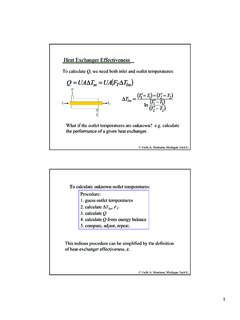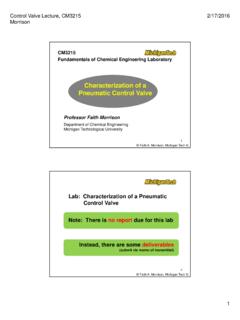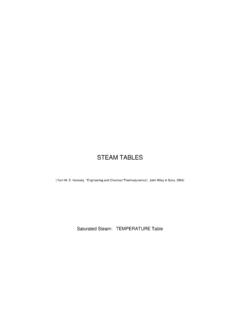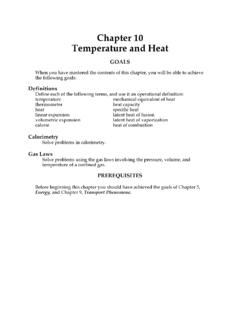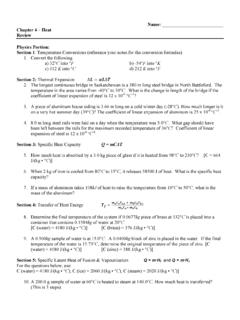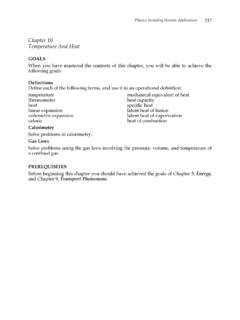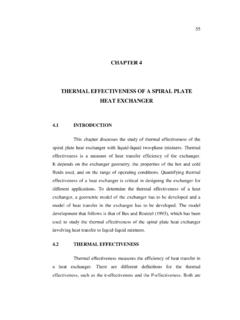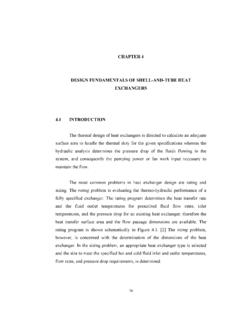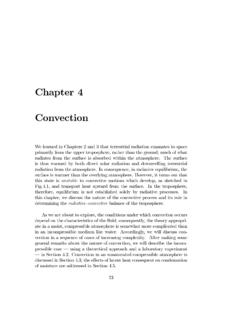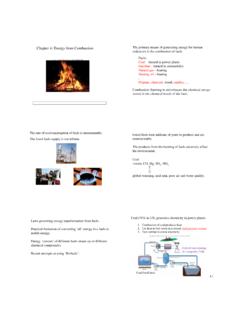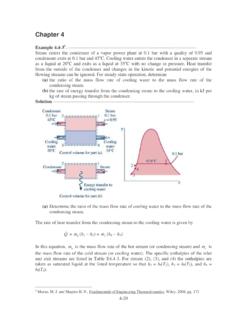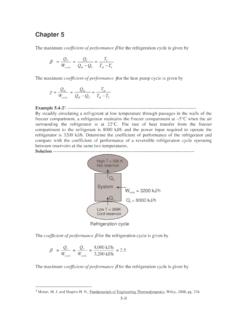Transcription of Chapter 4 - Student
1 Supplemental Material for Transport Process and Separation Process Principles Daniel L pez Gaxiola 1 Student View Jason M. Keith Chapter 4 Principles of Steady - State heat Transfer heat transfer is occurring in many chemical and separation processes as a consequence of a temperature difference. In Chapter 4, the following problem modules explain the heat transfer processes involved in fuel cell vehicles and in the processes for producing fuel for fuel cells. heat Loss through a Stainless Steel Bipolar Plate Cooling of a Fuel Cell heat Loss from an Insulated Pipe heat Loss by Convection and Conduction and Overall U heat Generation in a Solid-Oxide Fuel Cell Heating of Natural Gas in Steam-Methane Reforming Process Trial-and-Error Solution for Heating of Steam Heating of Ethanol in Reforming Process heat -Transfer Area and Log Mean Temperature Difference Laminar heat Transfer and Trial and Error Heating of Steam by a Bank of Tubes in High-Temperature Electrolysis Natural Convection in Bipolar Plate Vertical Channel Steam Condensation in a Fuel Cell Temperature Correction Factor for a heat Exchanger Effectiveness of heat Exchanger Radiation in Cylindrical Solid-Oxide Fuel Cell Cooling Channels in Fuel Cell Bipolar Plates Principles of Steady-State heat Transfer Daniel L pez Gaxiola 2 Student View Jason M.
2 Keith Example : heat Loss through a Stainless Steel Bipolar Plate Calculate the heat flux through a stainless steel bipolar plate in a polymer-electrolyte membrane fuel cell with a thickness of mm. The fuel cell is operating at a temperature of 80 C during the summer season in Houghton, Michigan where the temperature is 70 F. Strategy The equation for the heat flux obtained from Fourier s Law can be used to obtain the solution to this problem. Solution Equation of Geankoplis is defining the heat transfer per unit area as follows: ()1221qkTTAxx= We can substitute the values given in the problem statement into this equation, but first we need to convert the temperature outside the fuel cell to C: ()()T F3270 F 32T == T_____ C= Entering the temperatures inside and outside the fuel cell stack into the heat transfer equation, as well as the thickness of the bipolar plate represented by 21xx , we get: ()W_____qm K_____ K KA_____ m = 2qW_____Am= The thermal conductivity of steel was obtained from Table of Geankoplis.
3 Supplemental Material for Transport Process and Separation Process Principles Daniel L pez Gaxiola 3 Student View Jason M. Keith Example : Cooling of a Fuel Cell Air at a temperature of 25 C is being used for cooling a single cell fuel cell. The convective heat transfer coefficient of the air is C and is capable of removing heat at a rate of W. What would be the dimensions of the square surface of the fuel cell if its temperature must not exceed 50 C? Strategy The heat transfer rate by convection can be obtained using Newton's Law of Cooling. Solution The heat flux q when heat is being transferred by forced convection is defined as follows: ()SqhA TT = where: 2Wq heat transfer rate, m= 2Wh convective heat transfer coefficient, m K= ST temperature on the surface of the object, C= T temperature of the air, C = A = surface area of the fuel cell, m2 Air @ 25 C Air @ 25 C Principles of Steady-State heat Transfer Daniel L pez Gaxiola 4 Student View Jason M.
4 Keith To determine the dimensions of the surface of the fuel cell, we can substitute the given temperatures and heat transfer rate and solve for the area A to yield: ()2_____ WAW_____50 C 25 Cm C== m= Since the heat is being removed from the fuel cell through both the left and right faces of the fuel cell, this value of A must be divided by 2. Thus, 22fuel m_____ cmA21 m = 2fuel cellA_____ cm= The dimensions of a fuel cell with a square surface could be obtained as follows: 2fuel cellLA_____ cm== L_____ cm= Therefore, for a heat transfer rate of W, air at 25 C can be used to keep the surface area of a _____cm x _____cm fuel cell at a temperature of _____ C. Supplemental Material for Transport Process and Separation Process Principles Daniel L pez Gaxiola 5 Student View Jason M. Keith Example : heat Loss in Fuel Reforming Applications A pipe made of 308 stainless steel (schedule number 80) with a nominal diameter of " is carrying methane at a temperature of 400 C in a steam-methane reforming process for producing hydrogen.
5 The pipe is insulated with a layer of glass-fiber with a thickness of 1". Determine the temperature at the interface between the pipe and the glass fiber and the heat loss through the insulated pipe with a length of 15 m. The surface of the insulating material is at a temperature of 25 C. A schematic of the pipe is shown below: Strategy The equation for the heat loss through a pipe can be applied to the different layers in the pipe. Solution The heat loss through the walls of a cylinder is given by: inoutTTqR = where: Tin = temperature at the inner wall of the pipe, K Tout = temperature at the outer wall of the pipe, K R = resistance of the pipe to the heat transfer through its walls, KW Natural Gas @ 400 C T1 T2 T3 Principles of Steady-State heat Transfer Daniel L pez Gaxiola 6 Student View Jason M. Keith In this problem, we need to apply this equation for both the steel pipe and the insulated pipe.
6 The overall heat loss will be obtained using this equation for the insulated steel pipe. The resistance to heat transfer in cylindrical coordinates is calculated with the following equation: outinlmrrRkA = in this equation: rout = outer radius of the cylinder, m rin = inner radius of the cylinder, m k = thermal conductivity of the material, Wm K Alm = log mean area, m2 The log mean area of the pipe is defined as: outinlmAAA_____ln _____ = where Aout and Ain are the outer and inner surface areas of the cylinder, respectively. Applying the equations for resistance and the log mean areas to the steel and the overall pipe we have:Steel Pipe 121 21 2 TTqR = 211 2steellm,1 2rrRkA = 21lm,1 221 AAAAlnA = Overall 131 31 223 TTqRR =+ 31lm,1 331 AAAAlnA = Supplemental Material for Transport Process and Separation Process Principles Daniel L pez Gaxiola 7 Student View Jason M.
7 Keith To determine the log mean areas we need to look for the radius of the steel pipe in Appendix of Geankoplis. For the " pipe: rin = r1 = _____ m rout = r2 = _____m The radius of the pipe including the insulation is obtained by adding the thickness of 1" to the outer radius of the steel pipe. Hence, r3 = _____m + m = _____m With these diameter values and the length of the pipe, the areas A1, A2 and A3 can be calculated as shown in the following steps. A1 = 2 r1L = 2 ( m)( _____ m) = m2 A2 = 2 r2L = 2 (_____m)( _____ m) = _____m2 A3 = 2 r3L = 2 (_____m)( _____ m) = _____m2 The thermal conductivities for the glass fiber and the steel can be found in Appendix of Geankoplis and are shown below. The conductivity of the glass fiber was selected at the highest temperature available in Table The thermal conductivity of steel was obtained from Table steelWk_____m C= glass fiber Wk_____m C= Substituting the values we obtained into the equations for the individual layers yields: Steel Pipe 1221 21 2TT_____ C TqCR_____W == ()41 22_____ m _____ mm C == 222lm,1 222_____ m_____ m == Principles of Steady-State heat Transfer Daniel L pez Gaxiola 8 Student View Jason M.
8 Keith Overall 1 3_____ C _____ == + ()232_____ m mm C == 222lm,2322_____ m_____ mA_____ m == Hence, the heat loss through the insulated pipe is W. Since this answer represents the amount of heat lost per unit time, if we assume that the system is at steady state. The heat loss per unit time will be the same in the individual layers. Thus, we can use the equation for the heat loss through the steel pipe to determine the temperature at the steel-glass fiber interface. 21 2_____ C WC_____W == Solving for the temperature T2, we get: 2CT_____ C W _____W = 2T_____ C= As it can be seen, the temperature at the pipe - insulator interface is almost the same as the temperature of the inner wall of the steel pipe. This is because most of the heat is lost through the metal pipe due to the high thermal conductivity of steel in comparison to the thermal conductivity of the insulating material.
9 Supplemental Material for Transport Process and Separation Process Principles Daniel L pez Gaxiola 9 Student View Jason M. Keith Example : heat Loss by Convection and Conduction in a Steam-Methane Reforming Process Natural gas at 400 C is flowing inside a steel pipe with an inner diameter of in and an outer diameter of in. The pipe is insulated with a layer of glass-fiber with a thickness of 1 in. The convective coefficient outside the insulated pipe is hr F . The temperature on the external surface of the pipe is C. Calculate the convective coefficient of natural gas and the overall heat transfer coefficient U based on the inside area Ai, if heat is being lost at a rate of btu7115hrin a pipe with a length of ft. Strategy To determine the heat transfer coefficients, we will use the equation for heat loss for a multilayer cylinder.
10 Solution The heat loss through a cylinder with different layers is defined by the following equation: ioioiABoTTTTqRRRRR ==+++ where: Ti = Temperature on the internal surface of the pipe To = Temperature on the external surface of the pipe Ri = Convective resistance inside the pipe RA = Conductive resistance through the steel pipe RB = Conductive resistance through the insulation layer Ro = Convective resistance outside the pipe The resistance to heat transfer due to convection is defined as follows: conv1 RhA= Principles of Steady-State heat Transfer Daniel L pez Gaxiola 10 Student View Jason M. Keith where: h = Convective heat transfer coefficient A = Area of heat transfer The resistance of a cylinder to heat conduction is calculated as follows: outincondlmrrRkA = where: rout = Outer radius of the cylinder rin = Inner radius of the cylinder k = thermal conductivity of the material Alm = log mean area of the cylinder We can enter the definitions of the resistances due to conduction and convection into the equation for the heat loss to yield: ioo11iiisteelA ,lmglass fiberB,lmooTTqrrrr11h AkAkAh A = +++ In this equation: ri = inner radius of the steel pipe = in2= _____ in r1 = outer radius of the steel pipe = in2= _____ in ro = outer radius of the insulated pipe = _____ in With these values we can calculate the log mean areas AA,lm and AB,lm and the inner and outer areas of the insulated pipe.
